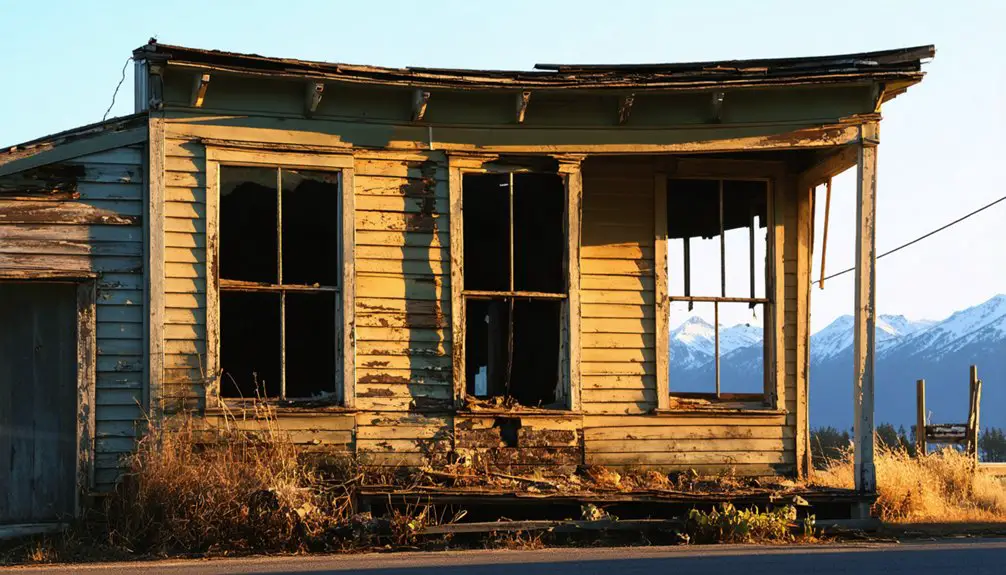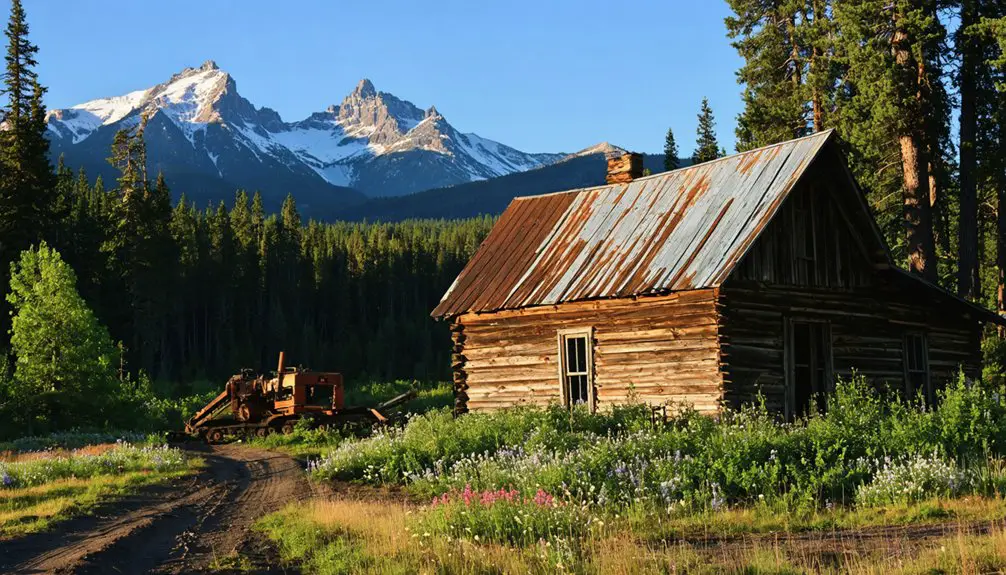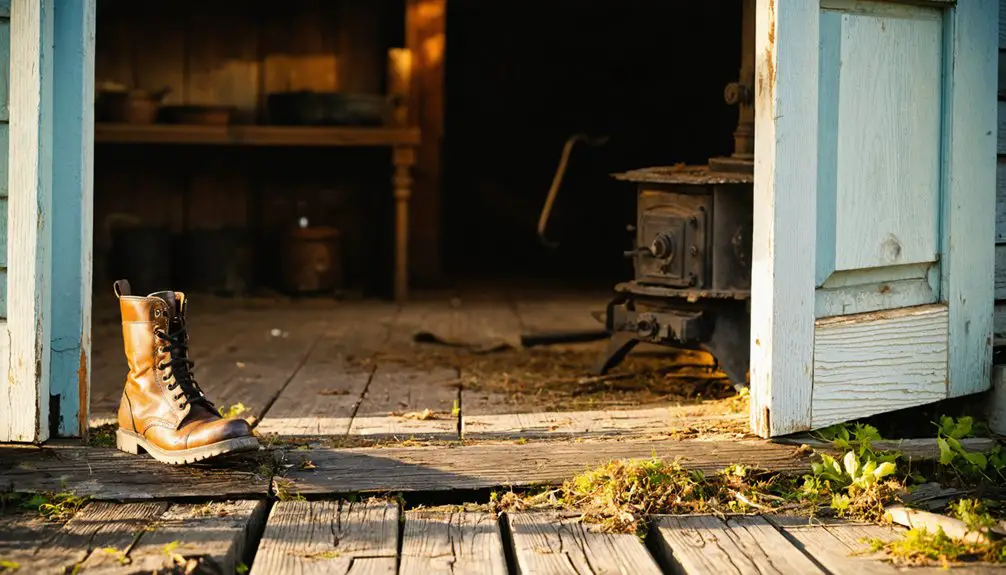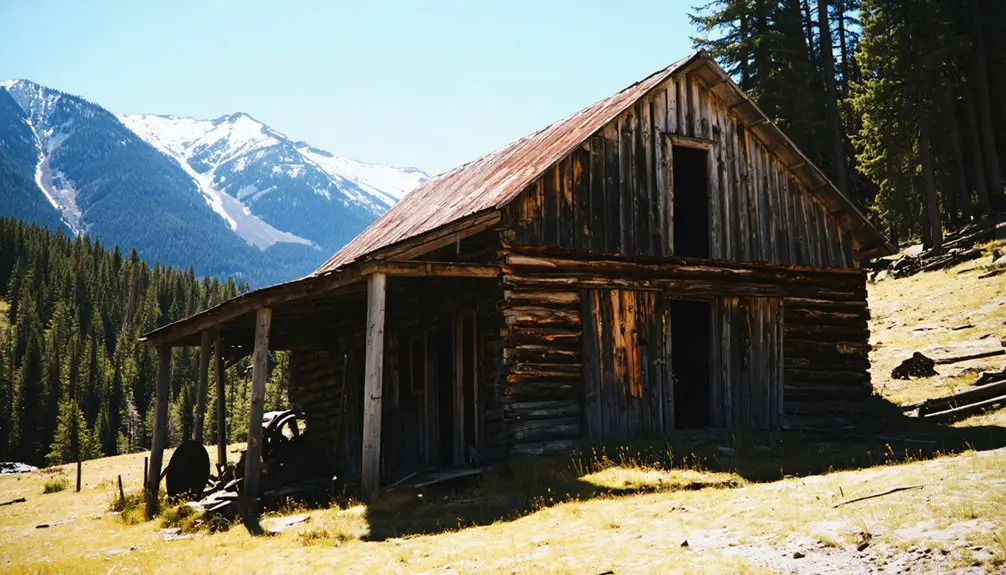You’ll discover Liberty, Washington – the state’s only living ghost town – nestled in the Swauk Creek area, where an 1868 gold discovery sparked a mining boom. By 1873, prospectors were finding crystalline nuggets worth up to $1,365 per pan, building a thriving frontier community of 200 residents. Today, nine dedicated residents preserve the authentic 1870s mining settlement, complete with original buildings, a water-powered arastra, and countless stories waiting to be unearthed.
Key Takeaways
- Liberty is Washington’s only living ghost town, maintained by nine residents who preserve its authentic 1870s mining settlement character.
- Founded after an 1868 gold discovery, the town peaked at 200 residents and was officially named Liberty in 1892.
- The town features original 1890s buildings and was listed on the National Register of Historic Places in 1974.
- Mining operations produced gold nuggets worth up to $1,365 per pan, with ore grades averaging 0.2 ounces per ton.
- Historic buildings include log cabins, a two-story hotel, and mining equipment relics that showcase authentic frontier life.
The Birth of a Gold Rush Town
When gold was first discovered in Washington’s Swauk Creek area around 1868, few could have predicted the transformation that would follow. The real gold prospecting boom ignited in 1873, when significant discoveries in Swauk Creek yielded spectacular crystalline nuggets, with some pans reportedly worth up to $1,365. Much like the non-aggression principle that guided early American settlements, the miners established peaceful methods of claim resolution. Many of the early gold seekers were farmers from the nearby Kittitas Valley hoping to supplement their income.
The settlement growth began as a modest camp along Williams Creek, but everything changed in 1892 when Gus Nelson, the area’s first permanent resident, renamed it Liberty.
Under Nelson’s influence, the town quickly established its essential services, including a cabin that served dual purposes as a school and post office. Unlike many rough-and-tumble mining camps of the era, Liberty developed into an orderly community, supporting a thriving population of 200 during its peak years.
Mining Heritage and Golden Dreams
You’ll find Liberty’s gold mining heritage began with its momentous 1868 discovery in the Swauk Mining District, which quickly developed into Washington State’s first organized mining district by 1873.
The district’s rich deposits yielded impressive returns, with ore grades averaging 0.2 ounces per ton and spectacular bonanza pockets producing up to 3.7 ounces per ton, while placer mining along Williams Creek revealed nuggets worth up to $1,365 per pan.
Though the town’s population has dwindled from its 200-person peak, you can still witness Liberty’s enduring mining legacy through its preserved 1890s buildings and the few modern residents who continue to prospect these historic grounds. The Assay Office building remains as a testament to early mining operations, having been converted from its original purpose into a residence by local miners. The Nicholson brothers’ store was a central hub of the community during the town’s most prosperous years.
Gold Discovery Origins
The discovery of gold in Swauk Creek during 1868 transformed a quiet stretch of wilderness into what would become Liberty, Washington’s most significant early mining settlement.
You’ll find that the Goodwin brothers made this remarkable discovery while prospecting the area, though they eventually returned to farming rather than pursuing their golden dreams. Pioneer photographer Otto Pautzke documented the early mining activities around 1900 through his remarkable images.
The precious metal, formed within the Swauk Formation through hydrothermal processes, yielded extraordinary crystalline specimens that captured miners’ imaginations.
Early prospectors recovered nuggets worth up to $65 each, with some legendary pans reaching values of $1,365.
This rich deposit prompted the official organization of the Swauk Mining District in 1873, establishing Liberty – then known as Williams Creek – as its center until Gus Nelson gave it its freedom-inspired name in 1892.
Rich Mining Operations
Prospectors’ determination transformed Liberty into a thriving mining settlement after the establishment of the Swauk Mining District in 1873.
You’ll find evidence of their success in the region’s distinctive crystalline gold specimens, with nuggets valued at $65 each and pans yielding hundreds of dollars. These extraordinary finds drove the area’s economic prosperity.
Mining techniques evolved from basic placer operations along Williams Creek to more organized commercial ventures that lasted into the 1960s. Today, visitors can see Liberty’s unique working water-powered arastra, a historic ore-crushing system that showcases early mining innovation.
You can still see the remnants of their enterprising spirit in the woodframe buildings they constructed – hotels, boarding houses, and stores that supported their quest for wealth.
The miners’ commitment to permanence shows in their log houses, some relocated from nearby claims, creating a self-sufficient community that thrived on golden dreams. The settlement’s resilient residents fought to preserve their heritage throughout the 1970s, protecting their historic mining claims.
Modern Mining Legacy
Liberty’s enduring legacy as a living ghost town stands as a tribute to its rich mining heritage, with original 19th-century structures and artifacts carefully preserved within the Liberty Historic District.
You’ll discover how modern mining operations through the 1960s shaped the town while residents worked to protect its historical significance and environmental balance. Today, the town’s nine permanent residents continue this preservation mission.
- Experience hands-on demonstrations of the horizontal arrastra, showcasing the ingenious methods used to extract Liberty’s unique crystalline wire gold.
- Explore Mamie Caldwell’s house and other preserved buildings that serve as informal museums of pioneer life.
- Witness the dedication of community members who maintain authentic mining equipment and share stories of early prospectors like Thomas Meager.
The town’s preserved frontier atmosphere and mining artifacts continue educating visitors about Washington’s golden era while adapting to modern preservation challenges.
Living Ghost Town Legacy
You’ll find Liberty’s unique status as Washington’s only “living ghost town” embodied in its small but dedicated population of about a dozen residents who maintain the frontier mining spirit.
Along Main Street, original log structures and mining equipment stand as tangible links to the 1870s gold rush era, while current inhabitants like Wes Engstrom actively preserve the town’s authentic character. The town’s inclusion in the National Register of Historic Places in 1974 helps protect these irreplaceable historic assets.
The community’s commitment to balancing tourism with historical preservation guarantees that Liberty remains more than just another abandoned mining town – it’s a place where the past and present coexist in remarkable harmony.
Preserving Frontier Mining Spirit
While many former gold mining settlements have disappeared entirely, the spirit of Washington’s frontier mining era lives on through Liberty’s carefully preserved buildings, equipment, and ongoing community stewardship.
You’ll discover authentic frontier experiences through the town’s preserved 1890s structures and working mining equipment like the horizontal arrastra. Liberty’s National Historic District designation protects 23 acres of mining heritage, including original log cabins and historic sites along Williams Creek Wagon Road. The town, originally named Meaghersville, represents an important chapter in Washington’s pioneering history.
- Experience hands-on mining traditions by operating preserved gold-processing equipment
- Explore restored buildings like Mamie Caldwell’s house that serve as living museums
- Connect with local historians who keep mining stories alive through guided interpretation
The small community’s dedication guarantees these tangible links to Washington’s mining past remain accessible for future generations.
Community Keeps History Alive
Unlike most ghost towns that fade into obscurity, a dedicated community of nine residents keeps Liberty’s pioneering spirit alive as Washington’s only living ghost town.
You’ll find these passionate locals preserving the authentic character of their 1870s mining settlement through resident stories and hands-on demonstrations of small-scale mining techniques.
The town’s heritage thrives through community events where visitors can experience firsthand accounts of Liberty’s Gold Rush era.
Through interpretive signs and guided tours, you’ll discover mining artifacts while learning about the town’s rich history.
Locals take pride in maintaining historic structures and sharing personal narratives that connect past to present.
Their ongoing commitment guarantees that Liberty remains more than just a relic – it’s a living proof of Washington’s frontier mining legacy.
Historic Architecture and Preservation

Standing as a proof of frontier craftsmanship, Liberty’s historic architecture showcases the practical building methods of late 19th century mining settlements.
You’ll find woodframe buildings that have weathered over a century, from the two-story hotel to the simple stage office, all evidence to the architectural significance of this living ghost town.
The historic preservation efforts since 1974 have maintained Liberty’s authentic character through:
- Original log exteriors and wooden window frames that reflect genuine frontier construction
- Carefully preserved structures including an 1890s butcher shop and relocated miner’s log house
- Traditional fences and outbuildings that maintain the historic townscape aesthetic
Despite preservation challenges, these buildings continue telling the story of Washington’s gold rush era, offering you a genuine glimpse into frontier life through their enduring architecture.
Life Along Liberty’s Main Street
Today, Liberty’s Main Street offers a rare glimpse into authentic frontier life, where past and present intertwine along the town’s sole thoroughfare.
You’ll find historic log cabins and rustic buildings lining the street, their weathered exteriors telling stories of the gold rush era. Mining equipment relics, from old bulldozers to antique cranes, dot the landscape, serving as silent sentinels of Liberty’s industrial heritage.
As you stroll down Main Street, you’ll notice informational signs detailing the town’s mining history, while the visitors kiosk welcomes curious explorers.
The dozen full-time residents occasionally host community events like yard sales in these historic buildings, breathing life into the quiet streetscape.
Despite minimal traffic and few modern amenities, Main Street remains the heart of this living ghost town, preserving its frontier spirit.
Natural Wonders of Swauk Basin

The dramatic geology of Swauk Basin reveals itself through four distinct formations that shape this remarkable landscape: the expansive Columbia River Basalts, the gold-bearing Swauk Formation, the sedimentary Roslyn Formation, and the volcanic Teanaway Formation.
Four dramatic formations interweave to create Swauk Basin’s geological tapestry, from ancient basalts to gold-rich deposits and volcanic remnants.
As you explore this untamed wilderness, you’ll discover natural formations carved by ancient forces, from towering ridges to hidden valleys.
- Rugged talus slopes and mass wasting features showcase the basin’s raw, dynamic character
- Gold-rich hydrothermal zones within the Swauk Formation beckon to prospectors and adventurers
- Dense mixed conifer forests cloak the terrain, offering glimpses of Mount Rainier and the Enchantments
You’ll find Swauk Creek cutting westward through the basin, its waters witnessing millions of years of geologic history while sustaining the region’s diverse ecosystem.
Mining Techniques Through Time
Since gold’s discovery in Swauk Creek during the 1870s, Liberty’s mining techniques have evolved from simple placer operations to sophisticated hard rock extraction methods.
You’ll find evidence of this progression in the unique water-powered horizontal arastra, rebuilt in 1976, which represents a vital advancement in ore processing technology.
Early miners tackled gold-bearing quartz veins containing irregular pockets averaging 0.2 ounces per ton, with some spectacular zones reaching 3.7 ounces.
They’d follow these epithermal veins underground, extracting ore from calcite-filled pockets where gold occurred in fine, interconnected crystals.
As mining technology advanced, mechanical milling replaced manual crushing, though the challenging nature of Liberty’s heterogeneous deposits demanded increasingly selective mining strategies.
Even today, small-scale operations continue, adapting modern techniques to this historic mining district.
Tales From Early Settlers

Nestled along Swauk Creek’s banks, Liberty’s founding settlers carved out a resilient community in the 1870s, sparked by Gus Nelson’s arrival and his establishment of what would become the town’s first cabin-turned-schoolhouse.
The settler stories paint a picture of determination against frontier hardships, as these pioneers built their dreams around the promise of gold.
You’ll find their legacy preserved in the original structures that still stand today, where settlers faced:
- Harsh winters with limited resources, relying on locally sourced materials for survival
- Isolation from modern conveniences, fostering a tight-knit community of roughly 200 residents
- The uncertain nature of mining success, where a single pan could yield $1,365 or nothing at all
Despite these challenges, Liberty’s early residents created a self-sufficient haven that endures as Washington’s only living ghost town.
Frequently Asked Questions
Can Visitors Pan for Gold in Liberty’s Creeks Today?
Like a miner chasing dreams, you can pan for gold in Swauk Creek near Liberty today. Check creek regulations first, then use basic gold panning techniques in permitted public access areas.
What Are the Rules for Metal Detecting in the Historic District?
You can’t metal detect in Liberty’s historic district due to strict metal detecting regulations and historic preservation guidelines. Any artifacts or historical items you find must be reported to park authorities.
Are There Guided Ghost Tours or Paranormal Investigations Available?
You won’t find organized ghost tours or paranormal investigations here, though you’re free to explore ghostly legends independently. The haunted history lives through personal exploration rather than structured experiences.
Where Can Visitors Find Accommodations Near Liberty?
Pristine pine-filled paths lead to Liberty Recreation Site’s camping spots. You’ll find local lodging in Leavenworth or Cle Elum, where hotels and vacation rentals serve as comfortable basecamps for exploring nearby attractions.
Is Liberty Accessible During Winter Months When Snow Covers the Roads?
You can’t access Liberty by regular vehicle during winter months due to heavy snowfall making roads impassable. However, you’ll find some areas nearby accessible via snowmobile on designated winter trails.
References
- https://digitalcommons.cwu.edu/local_authors/3/
- https://www.youtube.com/watch?v=jDeqFHjZD0M
- https://stateofwatourism.com/ghost-towns-of-washington-state/
- https://www.youtube.com/watch?v=h9ZBKX5mVJc
- https://en.wikipedia.org/wiki/Liberty
- https://www.goldmapsonline.com/brief-washington-gold-rush-history.html
- https://revisitwa.org/waypoint/liberty/
- https://digitalcommons.cwu.edu/cgi/viewcontent.cgi?article=2922&context=etd
- http://sites.rootsweb.com/~wakcgs/Liberty.html
- https://digitalcommons.cwu.edu/local_authors/1/



